Introduction: In this article, Melissa Davenport Berry writes another story tied to the Winthrop Fleet of 1630, focusing on the Avery family line. Melissa is a genealogist who has a blog, AnceStory Archives, and a Facebook group, New England Family Genealogy and History.
In 1905 the Norfolk Weekly News-Journal published an article under the heading “A Remarkable Ancestry,” and the report covered ancestral lines of one “Norfolk daughter” who was a member of the Nebraska Society of Daughters of the American Revolution.
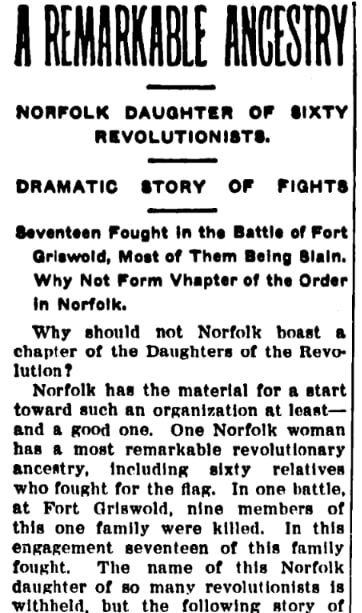
The lineage furnished by the subject of this article (whose name was withheld) reveals a family steeped in patriotic history centering around the courageous men who fought for America’s freedom.
Her name was Mrs. Frances Avery Haggard, daughter of Daniel and Elizabeth (Haxby) Avery, and wife of Dr. James Robert Haggard.

Mrs. Haggard was given the honor of naming the D. A. R. chapter when it was organized, as she was the member having the greatest number of ancestors (60!) who served in the Revolutionary War. She chose the name of her gr. great grandmother, Deborah Avery (1742-1825), daughter of Lieut. Col. Ebenezer Avery (of the Eighth Connecticut Militia) and his wife, Lucy Latham.
In June of 1896 the Deborah Avery Chapter was born.
At the massacre at Fort Griswold during the Revolutionary War, on 6 September 1781, 17 relatives of Deborah Avery were in the garrison. Of these, only one, Nathan Avery, son of Simeon Avery and Sarah Niles, escaped capture, serious wounds, or death.
From the Thames River Heritage Park Foundation:
Following the loss of American troops at the Battle of Groton Heights on September 6, 1781, the wounded soldiers were loaded into a wagon to be transported down the hill and onto the British ships. The men guiding the prisoners to the Thames River quickly lost control and were forced to release the wagon. It collided with a large tree, further injuring the already disabled soldiers. They were taken into the Ebenezer Avery House which stands today on the grounds of the Fort Griswold Battlefield State Park.
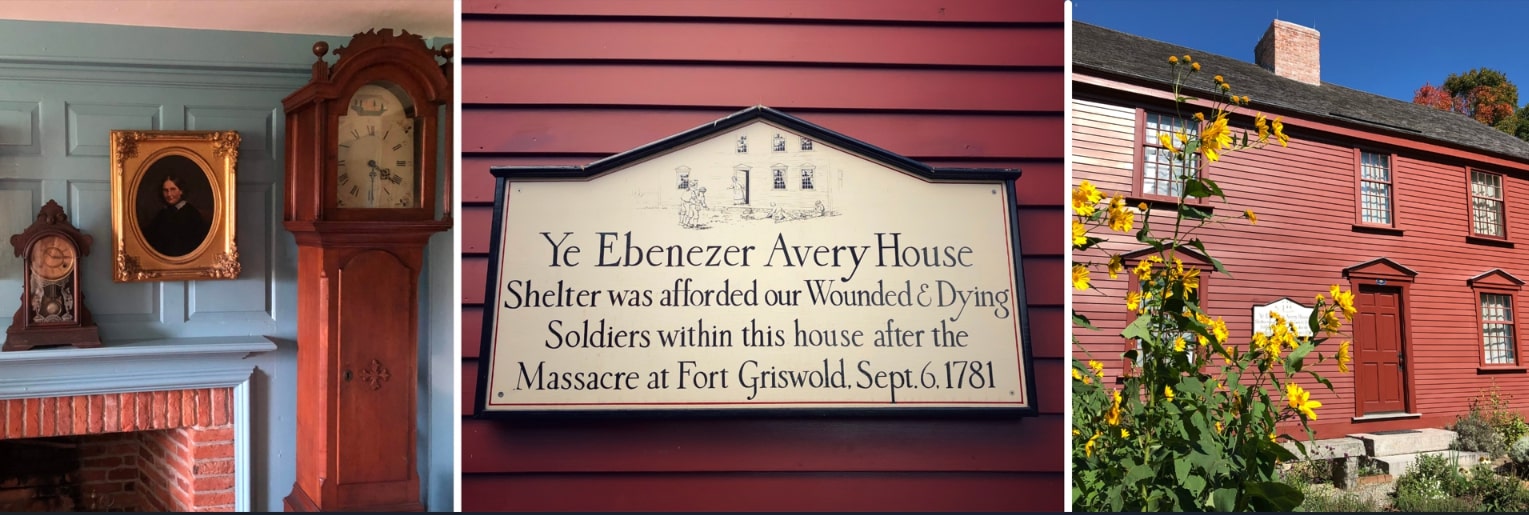
According to Mrs. Haggard, the first Avery to settle on America’s shores was Christopher Avery. He arrived in Salem, Massachusetts, 12 June 1630, on the flagship Arbella, one of the eleven vessels of the “Winthrop Fleet” that sailed from England’s Yarmouth, Isle of Wight, to Massachusetts Bay under the leadership of John Winthrop and funded by the Massachusetts Bay Colony.
Christopher brought his ten-year-old son James Avery (1620-1700), who won the favor of John Winthrop during the voyage which developed into a lasting friendship.
Christopher also brought with him a Bible which has several generations of Avery birth, death, and marriage records. It was placed on loan at the Dunham Bible Museum in 2013 by descendants.
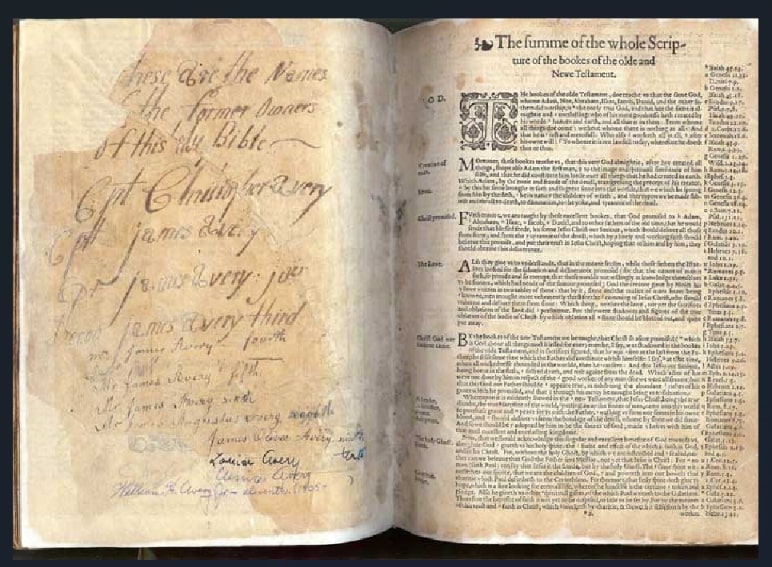
To see more views of this Bible, click here.
James Avery married Joanna Greenslade in Gloucester, Massachusetts, then moved to Groton, Connecticut.
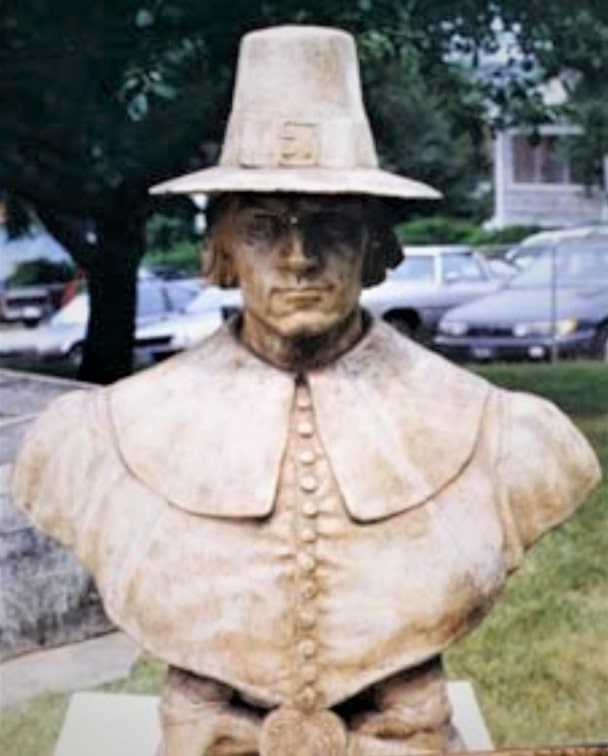
Capt. James and Joanna had a son James who married Deborah Stallyon. They had a son James III who married Mary Griswold – and their son Ebenezer Avery is Mrs. Haggard’s gr. great grandfather.
From the same Norfolk Weekly News-Journal article comes this description of some of the 60 Avery men who fought in the Revolutionary War.
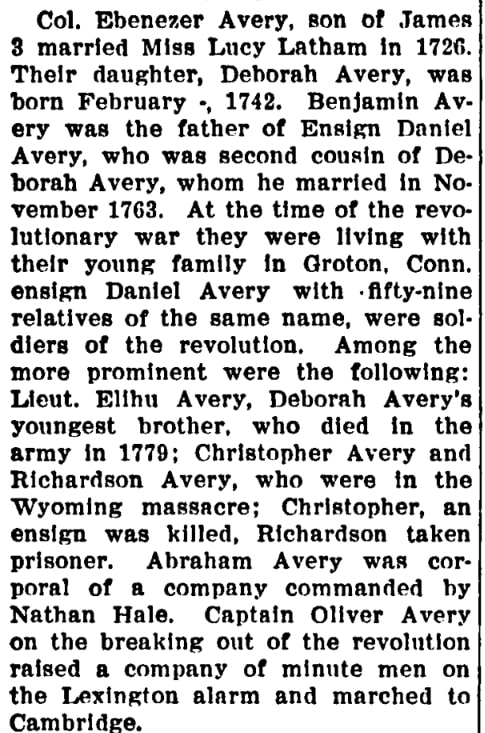
This article reported:
Col. Ebenezer Avery, son of James 3, married Miss Lucy Latham in 1726. Their daughter, Deborah Avery, was born February [1], 1742. Benjamin Avery was the father of Ensign Daniel Avery, who was second cousin of Deborah Avery, whom he married in November 1763. At the time of the Revolutionary War they were living with their young family in Groton, Conn. Ensign Daniel Avery with fifty-nine relatives of the same name were soldiers of the revolution. Among the more prominent were the following: Lieut. Elihu Avery, Deborah Avery’s youngest brother, who died in the army in 1779 [He married Thankful Avery, daughter of Benjamin and Thankful Avery, and left descendants. She married 2nd Ebenezer Rogers in 1787]; Christopher Avery and Richardson Avery, who were in the Wyoming massacre; Christopher, an ensign, was killed, Richardson taken prisoner. Abraham Avery was corporal of a company commanded by Nathan Hale. Captain Oliver Avery, on the breaking out of the revolution, raised a company of minute men on the Lexington alarm and marched to Cambridge.
Jonathan Avery entered the service at the age of nineteen and was [an] orderly in General Washington’s army when it left New York for Long Island. Simeon Avery was, [for] four years, an adjutant in a Connecticut regiment and so distinguished himself at Germantown, Monmouth, Valley Forge and Stony Point as to attract the particular notice of Washington, and at his solicitation was appointed his aide.
Col. Youngs Ledyard, who was killed at Fort Griswold, married Deborah Avery’s sister Mary, and her sister Lucy married George Colfax. Their son, Gen. William Colfax, was captain of Washington’s life guard, and his son, Schuyler Colfax, was vice-president of the United States in 1868. Ft. Griswold was located at Groton, Conn., the home of most of the Averys. When this place was attacked in 1781 by Bendict Arnold, the garrison was commanded by Col. William Ledyard and 167 men. When the gallant colonel was forced to surrender, he handed his sword to the British officer, who took the weapon and instantly murdered him with it.
To be continued…
Explore over 330 years of newspapers and historical records in GenealogyBank. Discover your family story! Start a 7-Day Free Trial
Note on the header image: this replica of Arbella was built in 1930 for the 300th anniversary of the Winthrop Fleet’s arrival at Salem on 12 June 1630, in conjunction with Pioneer Village, where it is now located. Credit: the Tichnor Brothers Collection, Boston Public Library, Print Department.
Related Article:

My Uncle was Charles Henry Avery, 1925–2015.